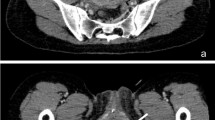Abstract
Introduction and hypothesis
The aim of this study was to retrospectively assess the extent and severity of the post-operative complications associated with the Pinnacle Pelvic Floor Repair Kit.
Methods
This is a descriptive analysis of 23 consecutive women who had a prolapse repair with either an anterior (n = 19) or posterior (n = 4) Pinnacle kit. The clinical records of all these patients were available for analysis. Pre-operative data and intra-operative complications were noted. All post-operative complications and repeat surgical interventions were recorded. In addition to pelvic floor symptoms, we looked specifically for pelvic pain and mesh contraction, exposure, extrusion or erosion. Complications were classified according to the joint IUGA/ICS system.
Results
Seventy percent (n = 16) of our cohort experienced at least one complication. All, except one, were following an anterior Pinnacle. 10 patients (43 %) had a tender vaginal mesh prominence, including a contraction band anteriorly or at the vaginal apex. Six (26 %) complained of associated buttock, groin or vaginal pain, while the tenderness was only detected during vaginal examination in 4 (16 %) patients. Three (13 %) patients required vaginal mesh excision for severe pain and one required a second procedure. Three patients (13 %) had vaginal mesh exposure and 8 (35 %) developed de novo stress incontinence. Two patients (8 %) developed symptomatic recurrent prolapse, one following mesh excision owing to large mesh exposure. Another patient had an anterior compartment prolapse above and below a tender contracted anterior vaginal mesh.
Conclusions
The Pinnacle kit was associated with a high incidence of post-operative complications in this small series.



Similar content being viewed by others
References
US Food and Drug Administration (2011) FDA Safety Communication: Update on serious complications associated with transvaginal placement of surgical mesh for pelvic organ prolapse. Accessed 13 July 2011
Altman D, Väyrynen T, Engh ME, Axelsen S, Falconer C; Nordic Transvaginal Mesh Group (2011) Anterior colporrhaphy versus transvaginal mesh for pelvic-organ prolapse. N Engl J Med 364(19):1826–1836
Sokol AI, Iglesia CB, Kudish BI, Gutman RE, Shveiky D, Bercik R, Sokol ER (2011) One-year objective and functional outcomes of a randomized clinical trial of vaginal mesh for prolapse. Am J Obstet Gynecol 206(1):86.e1–86.e9
Julian TM (1996) The efficacy of Marlex mesh in the repair of severe, recurrent vaginal prolapse of the anterior midvaginal wall. Am J Obstet Gynecol 175(6):1472–1475
Chen L, Ashton-Miller JA, DeLancey JO (2009) A 3D finite element model of anterior vaginal wall support to evaluate mechanisms underlying cystocele formation. J Biomech 42(10):1371–1377
Rane A, Kannan K, Barry C, Balakrishnan S, Lim Y, Corstiaans A (2008) Prospective study of the Perigee system for the management of cystocoeles–medium-term follow up. Aust N Z J Obstet Gynaecol 48(4):427–432
Moore RD, Mitchell GK, Miklos JR (2012) Single-incision vaginal approach to treat cystocele and vault prolapse with an anterior wall mesh anchored apically to the sacrospinous ligaments. Int Urogynecol J 23(1):85-91
Cayrac M, Letouzey V, Ouzaid I, Costa P, Delmas V, de Tayrac R (2012) Anterior sacrospinous ligament fixation associated with paravaginal repair using the Pinnacle device: an anatomical study. Int Urogynecol J 23(3):335–340
Baden WF, Walker TA (1972) Statistical evaluation of vaginal relaxation. Clin Obstet Gynecol 15(4):1070–1072
Haylen BT, Freeman RM, Swift SE et al (2011) An International Urogynecological Association (IUGA)/International Continence Society (ICS) joint terminology and classification of the complications related directly to the insertion of prostheses and grafts in female pelvic floor surgery. Int Urogynecol J 22(1):3–15
Diwadkar GB, Barber MD, Feiner B, Maher C, Jelovsek JE (2009) Complication and reoperation rates after apical vaginal prolapse surgical repair: a systematic review. Obstet Gynecol 113(2.1):367–373
Marcus-Braun N, von Theobald P (2010) Mesh removal following transvaginal mesh placement: a case series of 104 operations. Int Urogynecol J Pelvic Floor Dysfunct 21(4):423–430
Feiner B, Jelovsek JE, Maher C (2009) Efficacy and safety of transvaginal mesh kits in the treatment of prolapse of the vaginal apex: a systematic review. BJOG 116(1):15–24
Muffly TM, Barber MD (2010) Insertion and removal of vaginal mesh for pelvic organ prolapse. Clin Obstet Gynecol 53(1):99–114
Feiner B, Maher C (2010) Vaginal mesh contraction: definition, clinical presentation, and management. Obstet Gynecol 115(2.1):325–330
Hurtado EA, Appell RA (2009) Management of complications arising from transvaginal mesh kit procedures: a tertiary referral center’s experience. Int Urogynecol J Pelvic Floor Dysfunct 20(1):11–17
Aungst MJ, Friedman EB, von Pechmann WS, Horbach NS, Welgoss JA (2009) De novo stress incontinence and pelvic muscle symptoms after transvaginal mesh repair. Am J Obstet Gynecol 201(1):73.e1–7
Withagen MI, Milani AL, de Leeuw JW, Vierhout ME (2012) Development of de novo prolapse in untreated vaginal compartments after prolapse repair with and without mesh: a secondary analysis of a randomised controlled trial. BJOG 119(3):354–360
Tijdink MM, Vierhout ME, Heesakkers JP, Withagen MI (2011) Surgical management of mesh-related complications after prior pelvic floor reconstructive surgery with mesh. Int Urogynecol J 22(11):1395–1404
Maher C, Feiner B, Baessler K, Adams EJ, Hagen S, Glazener CM (2010) Surgical management of pelvic organ prolapse in women. Cochrane Database Syst Rev 14(4):CD004014
Vu MK, Letko J, Jirschele K, Gafni-Kane A, Nguyen A, Du H, Goldberg RP (2012) Minimal mesh repair for apical and anterior prolapse: initial anatomical and subjective outcomes. Int Urogynecol J 23(12):1753–1761
Rivaux G, Fatton B, Letouzey V, Cayrac M, Boileau L, de Tayrac R (2012) Utero-vaginal suspension using a bilateral vaginal anterior sacrospinous fixation with mesh. Preliminary results. Prog Urol 22(17):1077–1083
Conflict of interests
None.
Author information
Authors and Affiliations
Corresponding author
Rights and permissions
About this article
Cite this article
Jeffery, S.T., Brouard, K. High risk of complications with a single incision pelvic floor repair kit: results of a retrospective case series. Int Urogynecol J 25, 109–116 (2014). https://doi.org/10.1007/s00192-013-2156-1
Received:
Accepted:
Published:
Issue Date:
DOI: https://doi.org/10.1007/s00192-013-2156-1




